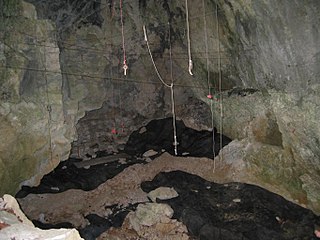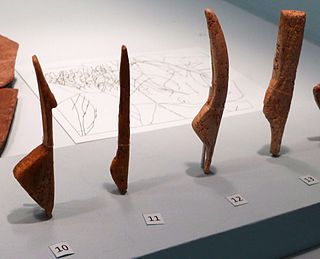Johannes Gustav Riek was a German archaeologist from the University of Tübingen who worked with the SS Ahnenerbe in their excavations, and led the teams that excavated the Vogelherd Cave in 1931, the Heuneburg Tumulus burial mounds in 1937 and the Brillenhöhle 1955–63.

The Tegelberg Cable Car, on the Tegelberg mountain near Schwangau in southern Bavaria. The cable car is 2,146.18 metres long, climbs a height of 892.5 metres, has a carrying cable of 48 mm in diameter and a hauling cable of 26 mm in diameter. It has two cabins each capable of transporting up to 44 persons. They are driven by a 2,540 KW engine. The cableway has a 38 metre high support pillar, made of reinforced concrete.
Gerd Zacher was a German composer, organist, and writer on music. He specialized in contemporary compositions, many of which feature extended techniques, and are written in graphic or verbal scores. He interpreted the scores of numerous contemporary composers, including John Cage, Juan Allende-Blin, Mauricio Kagel, György Ligeti, Hans Otte, Luis de Pablo, and Isang Yun. He is also known as an interpreter of the works of Johann Sebastian Bach.

Geissenklösterle is an archaeological site of significance for the central European Upper Paleolithic, located near the town of Blaubeuren in the Swabian Jura in Baden-Württemberg, southern Germany. First explored in 1963, the cave contains traces of early prehistoric art from between 43,000 and 30,000 years ago, including some of the oldest-known musical instruments and several animal figurines. Because of the historical and cultural importance of these findings, in 2017 the site became part of the UNESCO World Heritage Site Caves and Ice Age Art in the Swabian Jura.
Norbert Müller-Everling is a contemporary German artist working with concrete art.
Hermann Karl Lenz was a German writer of poetry, stories, and novels. A major part of his work is a series of nine semi-autobiographical novels centring on his alter ego "Eugen Rapp", a cycle that is also known as the Schwäbische Chronik.

Joachim Hahn was a German archaeologist and expert on the Upper Paleolithic era.

The Venus figurines from Gönnersdorf, at Neuwied, are paleolithic sculptures depicting the female body.
Horst Wolfgang Böhme is a German archaeologist with a focus on Late Antiquity / Early Middle Ages and research into castles.

Helmut Müller-Enbergs is a German political scientist who has written extensively on the Stasi and related aspects of the German Democratic Republic's history.

The State Academy of Fine Arts Stuttgart is a university in Stuttgart, Germany. Founded on 25 June 1761, and located since 1946 on the Weißenhof, the Academy, whose historical significance marks names such as Nicolas Guibal, Johann Heinrich von Dannecker, Bernhard Pankok, Adolf Hölzel, Willi Baumeister, Herbert Hirche, K.R.H. Sonderborg, Alfred Hrdlicka, Heinz Edelmann, Marianne Eigenheer, Richard Sapper, Joseph Kosuth, David Chipperfield, Joan Jonas, Micha Ullman, offers from all art universities in the federal state Baden-Württemberg the largest numbers of courses, namely all disciplines of the visual field, and not just in an organizational network but also under one roof. This is essentially the result of the connection of the former Academy of Fine Arts with the former School of Applied Arts in 1941 as Staatliche Akademie der bildenden Künste Stuttgart, which was reconstituted by Theodor Heuss in 1946 under the same name and which aimed at a broad training program as well as an intensified development in the following decades. Under the rectorate of Wolfgang Kermer, on 22 February 1975, the ″Gesetz über die Kunsthochschulen im Lande Baden-Württemberg (Kunsthochschulgesetz)″ passed by the Landtag of Baden-Württemberg came into force, which for the first time in the history of the State Academy of Fine Arts Stuttgart regulated the status and the essential relationships and which guaranteed the equality of rank with universities.

The Neckar-Odenwald Limes is a collective term for two, very different early sections of the Upper Germanic-Rhaetian Limes, a Roman defensive frontier line that may have been utilised during slightly different periods in history. The Neckar-Odenwald Limes consists of the northern Odenwald Limes (Odenwaldlimes), a cross-country limes with camps, watchtowers and palisades, which linked the River Main with the Neckar, and the adjoining southern Neckar Limes (Neckarlimes), which in earlier research was seen as a typical 'riverine limes', whereby the river replaced the function of the palisade as an approach obstacle. More recent research has thrown a different light on this way of viewing things that means may have to be relativized in future. The resulting research is ongoing.
Pfünz Roman Fort, Castra Vetoniana or Vetonianae, was a Roman cohort camp near Pfünz, a village in the municipality of Walting in the county of Eichstätt, Bavaria. It was built in about 90 A. D. on a 42-metre-high Jurassic hillspur between the valley of the Altmühl and that of the Pfünzer Bach stream. it is a component of the Rhaetian Limes which was elevated in 2005 to the status of a UNESCO World Heritage Site. Of historical importance are the remains of the double V-shaped ditches hewn out of the rock in front of the position, the one on the western rampart being the best preserved. In 1998, as part of the construction of a high pressure water system, the Bavarian State Office for Monument Protection carried out further test excavations. The archaeological record and rich finds from Pfünz, some of which are very rare, are seen as reasons for further studies in the future.

The Venus figurines of Petersfels are several small female statuettes from the Upper Paleolithic era, carved from jet lignite. The tallest figurine is called the Venus of Engen. The figurines were discovered in the Petersfels caves near Engen, Baden-Württemberg, excavated in 1927–1932 by Eduard Peters und Volker Toepfer and then in 1974–1976 and 1978 by Gerd Albrecht. They stand between 1.5 and 4 cm tall and are about 15,000 to 11,500 years old, created during the Magdalenian era. They are housed in the Museums of Freiburg im Breisgau and Engen.

The Adorant from the Geißenklösterle cave is a 35,000-to-40,000-year-old section of mammoth ivory with a depiction of a human figure, found in the Geißenklösterle cave in the Swabian Jura near Blaubeuren, Germany.

The Venus of Eliseevichi is a Venus figurine from the Epigravettian exhibited at the Hermitage Museum.
The history of Stuttgart is long, having its origins in the mid 10th century. However, the history of the land upon which Stuttgart stands has a far longer history dating back several thousands years to prehistoric peoples who sought the fertile soil of the Neckar river valley.

The proclamation of the German Empire, also known as the Deutsche Reichsgründung, took place in January 1871 after the joint victory of the German states in the Franco-Prussian War. As a result of the November Treaties of 1870, the southern German states of Baden, Hesse-Darmstadt, with their territories south of the Main line, Württemberg and Bavaria, joined the Prussian-dominated "German Confederation" on 1 January 1871. On the same day, the new Constitution of the German Confederation came into force, thereby significantly extending the federal German lands to the newly created German Empire. The Day of the founding of the German Empire, January 18, became a day of celebration, marking when the Prussian King William I was proclaimed German Emperor in Versailles.

Wolfgang Leidhold is a German political scientist, philosopher and artist. He works as a full professor at the Faculty of Management, Economics and Social Sciences of the University of Cologne, with a focus on political thoery and the history of ideas. The scope of his work ranges from the Paleolithic to the present day. Since the 1980s he has been exploring the history of experience and its transformations. He recently published the results of his research in “The History of Experience: A Study in Experiential Turns and Cultural Dynamics from the Paleolithic to the Present Day”. The main focus of his artistic work is painting and drawing. His works have been exhibited in the USA and Germany.
The Venus of Waldstetten is an approximately 15,000 year old Venus figurine made of quartzite. The find was apparently brought to the site by people. The figure is unprocessed in its basic form, but has engravings that were clearly carried out by humans. Therefore, it is interpreted as a female figure. It is 5.8 cm long with a maximum width of 1.9 cm; 2.5 cm thick and weighs 25.3 g. The site is located at Waldstetten in the Ostalbkreis on a terrain level between the Rems Valley and the Swabian strata landscape.














